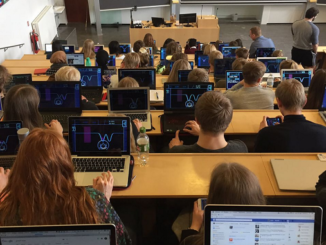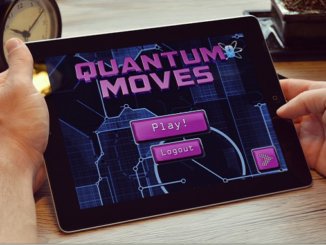
Quantum Moves: Quantum Leaps of Imagination
Today, we have a guest post from Pinja Haikka of the ScienceAtHome group. If you haven’t tried one of their games yet, you should!
Quantum Moves, the first citizen science project from the Danish ScienceAtHome group, is a game about moving atoms. This doesn’t sound too crazy, until you dive deeper into the world of atoms and start to grasp how strange the laws of quantum physics—the same laws that dictate the behavior of atoms—actually are.
You will soon discover that atom is not a little ball that you can simply pick up and push around. Physicists will tell you that the location of an atom is a vague concept, blurred by Heisenberg’s uncertainty principle. They will tell you that you should think of atoms as objects that are fuzzy, in many locations at the same time and should be described as abstract objects living in complex mathematical spaces.
Atoms are so strange that Erwin Schrödinger, one of the founding fathers of quantum physics, claimed, “We never experiment with just one electron or atom or (small) molecule. In thought-experiments we sometimes assume that we do; this invariably entails ridiculous consequences… we are not experimenting with single particles, any more than we can raise Ichthyosauria in the zoo”
Yet these days, experiments with single atoms are done routinely around the world. In 2012 the Nobel Price was awarded to Serge Haroche and David Wineland for their experimentation on single atoms, ions and photons. Around the same time a German group demonstrated how they can create a crystal of hundreds of atoms [1,2], while still being able to address and image them individually— that’s a whole zoo of Ichthyosauria for Prof. Schrödinger!
One of the zookeepers, Jacob Sherson, saw this experiment as something more than just atoms sitting idly in their cages. Controlling the atoms in all the right ways, they could be turned into a little army, completing one task after another—a miniature computer. And not just any computer, but one made of atoms, the oddballs that are in many places at the same time and do many things at the same time—a genuine quantum computer!
(At this point many people ask what quantum computers are and why they should be interested. If you’re one of these people, check out the stop-motion movie by the ScienceAtHome outreach team did to answer these questions https://www.youtube.com/watch?v=X24ombN09_k)
The problem is that the tasks that make a quantum computer run require the atoms to move around. As you very well know by now, that’s a tricky thing to do! While attacking this problem with the conventional tools of physicists, Jacob heard a podcast about gamification, the process of turning everyday task and problems into games. This made him wonder if a new angle on the problem would be more fruitful than the standard algorithms, eventually leading to the first version of Quantum Moves.
The big challenge Jacob faced was how to visualize an atom, the main character of the Quantum Moves game. The abstract object used to describe atoms is known as a wave function. This name comes from the famous equation of our zoo-skeptic, Prof. Schrödinger, which has the form of a wave equation—like the equations that describe the waves we are used to. In fact, it’s better to think of an atom as a wave, rather than as a little ball —or a quirky mathematical object!
A wave is simple enough to picture, which is why Quantum Moves is all about controlling the motion of a sloshy liquid. The way the liquid sloshes can seem a little strange at times (it’s because the sloshing is determined by the strange laws of quantum physics!), but this also means that the game is all the more fun to play!
Different levels of Quantum Moves correspond to different types of quantum operations and every time a player plays Quantum Moves, (s)he is actually finding a solution to the Schrödinger equation. The players look for solutions that are fast and stable, with very little sloshing in the end. This is not a simple challenge, yet people tackle it astoundingly well—better than physicists and better than computer algorithms [3]!
At the time of writing Quantum Moves has been played around 4 million times by 80,000 people around the world, but getting to these impressive numbers was not a simple path. It took four years of development and testing to turn Quantum Moves from the first version coded in Matlab to a beautiful and engaging game that can be played both on computers and on touch-screed devices.
Meanwhile, ScienceAtHome has grown from a small group of physicists to a project employing game designers, graphic artists and community managers. The future hold promises of more games, collaborations with cognitive scientists, psychologists and social scientists, studies on learning and problem solving, a small revolution in physics education—and of course lots more fun physics with our home-grown and house-trained zoo of atoms!
References
[1] J. F. Sherson, C. Weitenberg, M. Endres, M. Cheneau, I. Bloch & S. KuhrNature 467, 68–72 (2010)
[2] C. Weitenberg, M. Endres, J. F. Sherson, M. Cheneau, P. Schauß, T. Fukuhara, I. Bloch & S. Kuhr
Nature 471, 319–324 (2011)
[3] J. J. W. H. Sørensen, M. Kock Pedersen, M. Munch, P. Haikka, J. Halkjær Jensen, T. Planke, M. Ginnerup Andreasen, M. Gajdacz, K. Mølmer, A. Lieberoth & J. F. Sherson
Nature 532, 210–213 (2016)
This article was written by Chandra Clarke (@chandraclarke) for citizensciencecenter.com


